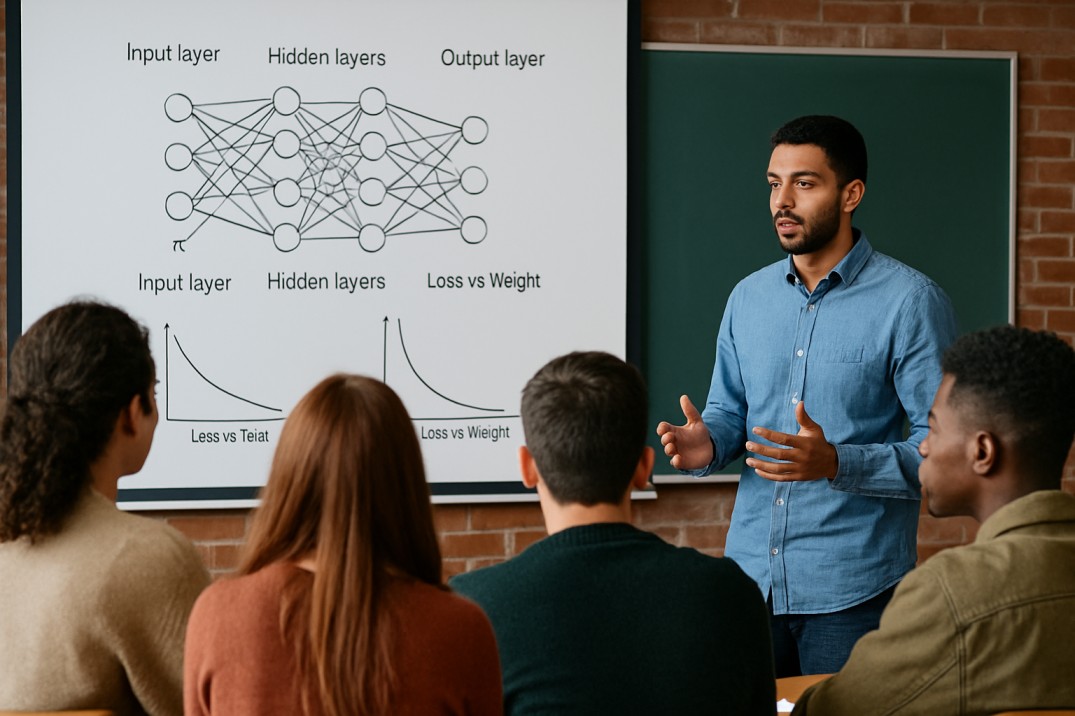What Do You Actually Learn in a Deep Learning Course?

What Do You Actually Learn in a Deep Learning Course?
If you're curious about enrolling in a deep learning course, one question probably comes to mind: What will I actually learn? With so many options out there, it's easy to feel overwhelmed.
This blog breaks down the real-world skills, concepts, and tools you can expect to gain from a well-structured deep learning course online - so you can choose a program that actually delivers value.
What is deep learning, and why does it matter today?
Deep learning is a branch of machine learning that uses algorithms called neural networks to analyze data, recognize patterns, and make predictions.
It powers many technologies we use every day:
- Facial recognition in phones
- Personalized recommendations on Netflix or Spotify
- Autonomous vehicles
- Chatbots and voice assistants like Siri or Alexa
- Fraud detection in banking
- Healthcare imaging and diagnostics
- Language translation tools
With industries adopting AI at scale, deep learning is no longer just a niche skill. It’s becoming essential for developers, analysts, data scientists, and even business leaders to understand how these systems work.
That’s why professionals across industries - from finance and logistics to marketing and education - are turning to deep learning courses online to stay relevant and future-proof their careers.
What are the prerequisites for learning deep learning?
Before jumping into deep learning, it's important to understand what foundational knowledge will help you make the most of your course.
Here’s what most courses expect you to know (or teach early on):
- Python programming: The standard language used in AI and ML workflows.
- Linear algebra: Vectors, matrices, dot products - all help in understanding how data flows through a neural network.
- Calculus: Basics of derivatives, gradients, and how optimization works.
- Probability and statistics: Understanding distributions, sampling, and metrics like mean, variance, and standard deviation.
- Machine learning fundamentals: Supervised vs. unsupervised learning, model training, evaluation metrics, etc.
Many beginner-friendly deep learning courses online offer crash courses or modules on these topics. But if you already have this knowledge, you’ll progress faster and grasp deeper concepts more easily.
What core concepts will you learn in a deep learning course?
Let’s break this down into the main modules you’ll typically encounter in a high-quality deep learning certification program:
1. Neural Networks and Deep Architectures
- What artificial neural networks are and how they work
- Understanding weights, biases, activation functions
- Architecture components: input layer, hidden layers, output layer
- Forward and backward propagation
- Cost functions and learning algorithms
2. Training Deep Models
- Optimization techniques: stochastic gradient descent (SGD), Adam optimizer, RMSprop
- Backpropagation: how networks learn from data
- Batch processing and mini-batch gradient descent
- Regularization: L1/L2, dropout, and early stopping
- Avoiding overfitting and underfitting
3. Convolutional Neural Networks (CNNs)
- Used primarily in computer vision
- Concepts: filters, kernels, feature maps, max pooling
- Real-world use cases: image classification, facial recognition, object detection
- Architectures like LeNet, AlexNet, VGG, ResNet
4. Recurrent Neural Networks (RNNs)
- Suitable for sequential or time-series data
- How RNNs process memory over time
- Challenges like vanishing gradients
- Advanced variants: LSTM (Long Short-Term Memory), GRU (Gated Recurrent Units)
- Applications: language modeling, time-series forecasting, speech recognition
5. Transformers and Attention Mechanisms
- Introduction to the breakthrough architecture behind modern NLP tools
- Understanding self-attention and positional encoding
- Popular models: BERT, GPT, T5, RoBERTa
- Real-world applications in chatbots, summarization, and question-answering systems
6. Autoencoders and Generative Models
- Denoising autoencoders and representation learning
- GANs (Generative Adversarial Networks): generator vs discriminator
- Applications in image generation, synthetic data creation, and art
7. Transfer Learning
- Using pre-trained models to solve new problems with less data
- Fine-tuning vs feature extraction
- Applications in domains where labeled data is scarce
8. Hyperparameter Tuning and Model Optimization
- Choosing the right learning rate, batch size, number of epochs
- Grid search, random search, and Bayesian optimization
- Tools like Optuna and Ray Tune
9. Model Evaluation and Deployment
- Metrics: accuracy, precision, recall, F1-score, AUC-ROC
- Confusion matrices and error analysis
- Model deployment using Flask, FastAPI, Streamlit
- Integrating models into real-time applications
- Using Docker, AWS, or GCP for scaling and serving models
What kinds of projects do you build during the course?
A well-designed deep learning course online includes hands-on projects that simulate industry use-cases. You’ll likely work on:
- Building a CNN for handwriting recognition (MNIST dataset)
- Face mask detection using real-time camera input
- Image style transfer project (e.g., making photos look like paintings)
- Text classification using LSTM or GRU
- Sentiment analysis on Twitter or IMDB reviews
- Generating new images with GANs
- Forecasting stock prices using RNNs
- Creating your own chatbot with sequence-to-sequence models
These projects help you:
- Solidify your learning through practice
- Build a portfolio for job applications
- Gain confidence working with real-world datasets
What tools and libraries are typically taught?
To build, train, and deploy models, you'll work with:
- Python
- NumPy and Pandas (data handling)
- Matplotlib and Seaborn (visualization)
- TensorFlow and Keras (model building)
- PyTorch (especially for research and flexibility)
- OpenCV (for computer vision tasks)
- Scikit-learn (for integrating ML with DL)
- Google Colab and Jupyter Notebooks (interactive environments)
- Flask/Streamlit (for deployment)
You’ll also get experience with cloud tools (AWS, GCP) for model training and deployment at scale.
How is theory balanced with practice?
Good courses keep the balance tight:
- Every theoretical concept is followed by a coding assignment
- You'll get quizzes to reinforce math and architecture knowledge
- You’ll build models from scratch before using high-level APIs
- Peer reviews and project feedback help you iterate and improve
This mix helps make sure you don’t just understand what deep learning is, but also how to apply it in the real world.
Will you learn how to read research papers or build cutting-edge models?
In more advanced programs, yes. Some online courses integrate:
- Walkthroughs of seminal papers (like “Attention Is All You Need”)
- Implementing models from academic publications
- Understanding how to contribute to open-source libraries
- Training models on custom or domain-specific datasets
This is especially useful if you want to:
- Work in R&D
- Contribute to academic or open-source AI work
- Transition into AI research roles
How do you know if a course is industry-relevant?
Look for the following signs:
- Projects that mimic actual job tasks (not toy datasets)
- Instructors with real-world experience or PhDs in AI
- Use of production-grade tools (like PyTorch Lightning, MLflow, etc.)
- Career services or mentorship (bonus)
- Alumni working at AI-first companies
Also check:
- Date of last course update
- Community size or learner engagement
- Real success stories or project showcases
How important is mentorship and peer learning?
Very. Learning deep learning can be overwhelming solo.
Courses that include mentorship often:
- Help resolve doubts faster
- Provide code reviews and project feedback
- Keep you accountable with deadlines
- Create a sense of community and progress
Peer learning also exposes you to new ideas, better code practices, and collaborative problem solving.
Do deep learning certificates help in getting hired?
A certificate can:
- Validate your effort and skills to employers
- Help you stand out if you’re from a non-tech background
But certificates alone don’t land jobs. You’ll still need:
- A strong GitHub portfolio
- Clear project documentation
- A LinkedIn presence with shared learning
- Ability to explain your projects in interviews
Focus on courses that give you something to show, not just something to say.
How long does it take to finish a deep learning course?
For most learners, a beginner-to-intermediate level deep learning course takes around:
- 8–10 hours per week for 3–6 months
- Extra time for larger capstone projects
If you're learning part-time, expect 4–8 months before you feel confident applying for roles or internships. Full-time learners can cut this down to 2–3 months.
Consistency matters more than speed.
What careers can this course help you explore?
Completing a deep learning certification can open up doors to:
- Deep Learning Engineer
- Computer Vision Specialist
- NLP Engineer
- AI Research Assistant
- Data Scientist with DL focus
- ML Engineer
You can also freelance, contribute to open-source projects, or join AI startup teams. Many developers also use deep learning skills to level up in adjacent roles.
Final Thoughts
A great deep learning course online teaches you far more than just code. It teaches you how to think, experiment, fail, and improve - just like a real engineer or researcher.
If you're investing in one, choose a course that:
- Has a structured but practical curriculum
- Uses current tools and libraries
- Pushes you to build meaningful projects
- Offers community, feedback, or mentorship
Don’t just learn deep learning. Learn it the right way.
Read more . . .
Join a thriving global community of learners
Our community across all our learning platforms spans over 56 countries and over 8000 learners
Weekly updates on AI and Data Sience
Be a part of a vibrant AI community





.png)














